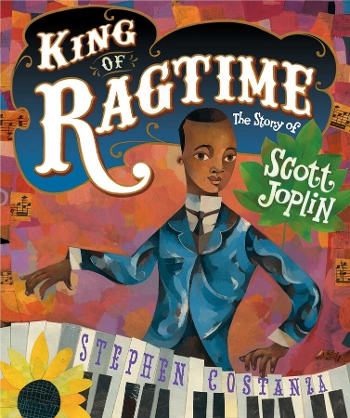In music, syncopation is a mixture or variety of rhythms or beats that are played together. These rhythms form the foundation of several types of dance music, particularly ragtime. Stephen Costanza’s illustrations in King of Ragtime depict composer Scott Joplin’s use of syncopation through complex collage work, thoughtful use of vibrant colors, and a mixture of artistic styles. We can almost hear "Maple Leaf Rag" as we turn the pages.
 How can an illustrator capture the essence of music with an image? The answer to that question can be found in Stephen Costanza's picture-book biography King of Ragtime: The Story of Scott Joplin.
How can an illustrator capture the essence of music with an image? The answer to that question can be found in Stephen Costanza's picture-book biography King of Ragtime: The Story of Scott Joplin.
In music, syncopation is a mixture or variety of rhythms or beats that are played together. These rhythms form the foundation of several types of dance music, particularly ragtime. Costanza’s illustrations depict composer Joplin’s use of syncopation through complex collage work, thoughtful use of vibrant colors, and a mixture of artistic styles. We can almost hear "Maple Leaf Rag" as we turn the pages of this wonderful biography.
Scott Joplin was born in rural North Texas in the late 1860s. His father had been a slave but his mother, a free woman. Costanza portrays Joplin’s early life as a sharecropper’s son in the book’s opening spread, a brilliantly conceived collage reminiscent of folk-art story quilts. Joplin’s family and neighbors loved music, and they can be seen in the first part of this book singing, dancing, and playing instruments together. Costanza is at his best as an illustrator when he is showing his characters in motion. The graceful surrealistic figures add energy and vitality to the book. There are no static images on these compelling spreads; everyone is moving.
Around the age of seven, Joplin and his family moved to Texarkana so that his father could work for the Texas & Pacific Railway. I love Costanza’s gridlike depiction of the Red River Valley as he introduces us to the next phase in Joplin’s life. His mother found work as a housekeeper, and as luck would have it, the family had a piano. Joplin began to play that piano while his mother did the chores. There is beauty in the tiny details Costanza brings us, such as the way young Scott bends his fingers at the keyboard and the concentration and resolve we see in his eyes while he plays. Determined to nurture their son’s interest in music, Joplin’s family arranged for him to receive lessons from a recent immigrant from Germany.
Joplin learned quickly and developed his own style of playing the piano. When he was old enough, the young musician left home, played in saloons and dance halls along the Mississippi Valley, performed in cafes outside the Chicago World’s Fair, and eventually settled in Sedalia, Missouri, where he formally studied music, wrote his compositions, and published "Maple Leaf Rag."
Like a dance tune full of syncopated rhythms, Costanza revisits previously established motifs — musical notes; trees and leaves; patchwork folk art; and fluid, surrealistic dancers — throughout the book’s later spreads. The original “beat” is always there, but it has been reworked to add nuance.
As I contemplate what this book does best and how it fits into the Caldecott’s definition of “distinguished American picture book for children,” two things come to mind. First and foremost, as I read and reread this book and consider its illustrations, the criterion of “excellence of pictorial interpretation” stands out for me. If ragtime represents a style of music that borrows bits and pieces of its rhythms and beats from other styles and sources and remixes them into something new and fresh, then that is exactly what Costanza accomplishes with his illustrations. Numerous folk-art styles, delicate collage work that mimics story quilts, and hints of cubism and surrealism can all be seen throughout the various spreads of this biography. Costanza, a musician himself, has created images that look like ragtime sounds. That’s no easy task and speaks to the concept of “pictorial interpretation” of subject in a distinct and original way. Perhaps the hardest part of illustrating a picture-book biography is to bring the person and the setting to life through that delicate dance between text and images. Costanza achieves that and more in this book. The poetic text describes Scott Joplin’s life and his music, but the illustrations bring Joplin to life.
The criteria for the Caldecott also tell us that “excellence of execution in the artistic technique” is essential in determining distinction. Costanza’s skill as an artist truly shines in this biography. The illustrations were rendered in wax pastel, gouache, and collage. Costanza’s line work is always on point, especially in those illustrations in which his characters are dancing. His color palette is intricate as well as provocative. These colors are not just on the page to make the layout look bright and beautiful. Rather, they are used to make us stop and think about Joplin, his music, and the time and places he lived his life. What also impresses me about the art is that Costanza never forgets his audience. Yes, the illustrations are innovative and occasionally sophisticated, but they always remain friendly to the eyes of the children who will read and delight in this book.
So, Caldecott or not? I say yes. Indeed, I could see King of Ragtime with one or two shiny stickers, come January. I hope the Caldecott committee agrees. We’ll have to wait and see.

RELATED
ALREADY A SUBSCRIBER? LOG IN
We are currently offering this content for free. Sign up now to activate your personal profile, where you can save articles for future viewing.







Add Comment :-
Be the first reader to comment.
Comment Policy:
Comment should not be empty !!!